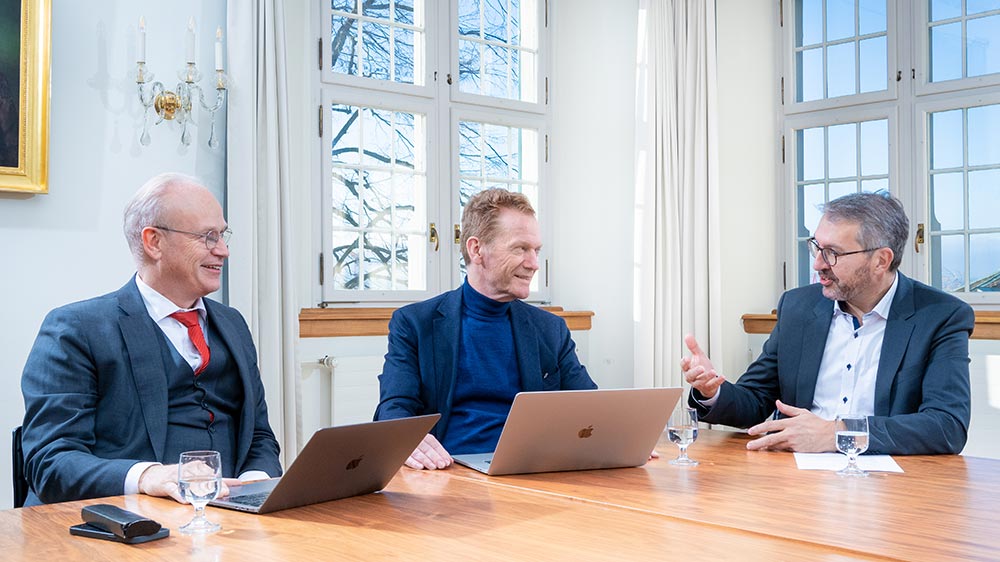Employees Welcome Flexible Working Model

The world of work is changing rapidly, with technological advances opening up many new opportunities – accelerated by the pandemic. In order to take advantage of these opportunities and at the same time meet the requirements of an on-site university, UZH introduced a new working model at the beginning of May 2022. According to the new model, employees must be on site at UZH for at least 60 percent of their weekly working hours. Mobile working is possible for the remaining hours if it is compatible with the operational needs and the tasks of the employees.
What do UZH employees think of the new model? To find out, the UZH Center for Leadership in the Future of Work conducted a survey earlier this year on behalf of the Executive Board of the University. It found that the 60-40 model fits well with employees’ preferences. The respondents were asked about how they organized their work before the pandemic, their experiences with the new working model and any concerns they may have about it, among other things.
Satisfaction has increased
Their answers showed that satisfaction with the working model has increased by an average of seven percentage points compared to before the pandemic. UZH staff welcome flexible arrangements, but they also appreciate the advantages of working on-site.
In the following interview, Executive Board members Christian Schwarzenegger, Stefan Schnyder and François Chapuis discuss the survey results and explain what impact they will have on the ongoing development of UZH’s work culture.
Christian Schwarzenegger, what makes a good work culture?
Schwarzenegger: A good work culture is based on the knowledge, experience, mutual respect and social skills of all employees, as well as on good leadership and appropriate and attractive conditions that need to be adapted to changing needs from time to time. We see the development of the UZH work culture as an ongoing and shared learning process. The introduction of the new working model in May 2022 was one step in this process, with further steps to follow.
Stefan Schnyder, how will UZH go about developing its work culture?
Schnyder: The pandemic greatly accelerated many trends. This presents opportunities, but also the risk of overextending ourselves as an organization. We want to steer this momentum toward developments which can be maintained over the long term and which we will keep reviewing with a critical lens every step of the way. We now know what experiences and expectations our employees had regarding mobile working in the summer of 2022. We will repeat the survey regularly in order to monitor and reflect on developments.
“The survey results show how important it is to find a good balance between working on site and from home.”
Stefan Schnyder
What conclusions do you draw from the results?
Schnyder: The survey results show how important it is to find a good balance between working on site and from home. Employees obviously appreciate the opportunity to work flexibly. Many would welcome a solution that goes even further, if compatible with operational requirements and line managers’ expectations. At the same time, however, the survey also clearly shows that in-person attendance is fundamental for a sense of belonging, and that employees feel more valued when they are on site. So it’s important to make sure we spend enough time in our offices and labs – and to deliberately dedicate at least some of that time to cultivating a spirit of cooperation and teamwork with our colleagues.
Schwarzenegger: According to the survey, the most important reason people give for working on site is the social interaction. We can communicate remotely with digital tools, but a true, vibrant sense of community only happens in person. For social interaction to take place at all, enough other people need to be around. The presence of others is vital for team cohesion, spontaneous conversations and an inspiring campus life. The 60-40 model encourages people to be present on site at the same time as their colleagues, thus meeting the human need for interaction.
“The presence of others is vital for team cohesion, spontaneous conversations and an inspiring campus life.”
Christian Schwarzenegger
According to the survey, leaders and managers are somewhat more skeptical about the new working model than other employees. Why is that?
Schnyder: For those in leadership roles, flexible working brings with it more responsibility. It is more complex and requires greater coordination to manage a team in which some members are in different locations some of the time than when all employees are in the same place all the time. If team members rarely see each other face to face, line managers need to take specific measures to ensure a good team spirit is maintained. Finding the optimum combination of on-site and mobile work isn’t easy – but it’s important that the right balance is struck for a flexible working model to be successful. Human Resources offers a consulting and coaching service to support leaders and managers.
Professors at UZH also have leadership responsibilities. What specific challenges do they face?
Schwarzenegger: Our professors reflect the full diversity of UZH. Preferences and challenges vary widely by discipline. In the natural sciences and medicine, the work of researchers and assistants is very different than in the arts and humanities, for example. Activities in the lab or clinic have very different rules and requirements than work in offices and libraries. We have therefore launched a pilot project in which interested professors from all faculties are developing ideas on how to combine a vibrant campus culture with digital technologies and mobile forms of work. (BOX)
François Chapuis, what does the change in work culture mean for space requirements at the university?
Chapuis: In the longer term, we need spaces that can be used in more diverse ways. The pandemic increased our awareness of this need. What makes on-site presence so important, and what we missed so much while we were working from home, is social interaction. This interaction is only possible in suitable spaces. On the other hand, in the survey many employees clearly expressed their need for space where they can concentrate and work in peace. We will take these needs into account when constructing and remodeling buildings as well as when organizing and furnishing them.
“We need more diversely usable spaces in the longer term.“
François Chapuis
How do you think things will progress from here?
Chapuis: We are moving in the direction of greater differentiation of available spaces. Until now, we probably considered our own desks as our home base at work. In the future, we may also consider places in which we meet others and network as our home base. This idea is also alluded to in the name of the planned FORUM UZH.
Does greater flexibility in the choice of work location mean that we pay more attention to how we work on site than we did before?
Chapuis: Many employees tell me that they now structure their time on site more consciously than before. I think that’s a positive development. Most employees’ time on site involves a variety of different forms of activity. Roughly speaking, there is a mix of concentrated individual work, collaborative work, routine tasks, confidential tasks, and breaks. Ideally, all UZH employees would be able to choose a suitable environment for each of the aforementioned categories of activity, e.g. disturbance-free areas for quiet work and more open areas for exchanging ideas with colleagues. In the long term, we plan to use this concept when planning new buildings or premises at UZH. This is already partially the case in the UZI 5 building, in the Functional Genomics Center and in the Westpark office building. However, given the size and diversity of UZH, this process will take years. We will proceed carefully and try to find the most suitable solution in each case in consultation with the employees concerned.
You have often described the development of the work culture at UZH as a shared learning process. What is the aim of this process?
Schwarzenegger: The aim is to have motivated and happy employees who can give their best and develop their skills at UZH.
Schnyder: Pleasant and modern working conditions are a prerequisite for this. Good leadership is needed at all levels so that staff feel appreciated, have a sense of connection with their teammates, and see perspectives for development. Up-to-date technical infrastructure and modern workspaces in which the rich diversity of campus life can flourish are equally necessary.
